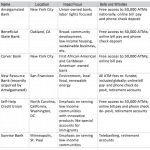How to Become an Impact Investor: Five Tips to Align Your Investments With Your Values
A recent report by the Forum for Sustainable and Responsible Investment (US SIF) found that environmental, social and governance (ESG) investing accounts for $12 trillion in assets in the U.S., with climate change as the issue of highest focus. While many environmentally conscious impact investors reached for their checkbooks on Giving Tuesday this past November to donate to nonprofits focused on the conservation of natural habitats and resources, they’re also thinking about how they can make more of an impact year-round in the wake of the recent unsettling United Nations report on climate change.
Using investments to leverage philanthropy is one of the most promising approaches to helping solve the world’s social and environmental challenges — from slowing and mitigating climate change to promoting good corporate citizenship and achieving gender equality — while also meeting financial objectives across the risk-return spectrum. And as impact investing has become more mainstream, even traditional investment firms have embraced the idea of investing for more than solely a financial return.
One Foundation’s Experiment with Impact Investing
The Russell Family Foundation took an exploratory leap into impact investing in 2004 to test the hypothesis that it could better meet philanthropic goals by using tools beyond grant-making. But taking into consideration non-financial factors in sizing up investment opportunities was new territory fraught with the risk of having to sacrifice financial returns to achieve impact.
Initially, the family decided that allocating $1 million from its foundation’s endowment to pilot mission-aligned investments was critical to leading by example and living the change it wanted to see. But by June 30, 2018, approximately 74 percent of the foundation’s $140 million endowment portfolio was mission-aligned, around themes ranging from affordable housing and the environment, to equity and inclusion. During the five-year period ending in June 2018 — the timeframe when the majority of the foundation’s investments were transitioned to impact — the portfolio out-performed its comparative performance benchmark by 2.7 percentage points on an annualized basis (7.9 percent versus 5.2 percent)[1].
A Growing Investor Demand for Impact Products
The belief that impact portfolios can often meet or exceed broad market performance, both on an absolute and a risk-adjusted basis, is becoming more widely accepted as the field matures and ESG performance criteria gain traction with investors. This awareness — coupled with growing interest in big challenges involving climate change mitigation, social issues such as diversity and gender equality, and conversations around good corporate citizenship — has triggered a surge in investor demand for ESG strategies and a proliferation of products to meet a wide range of needs.
While the new landscape and its attendant lexicon and metrics can seem daunting at times, getting started in impact investing is actually quite simple. It starts with knowing what you already own and parsing and prioritizing what you care most about. For advisors, helping clients navigate choices and find their comfort zone with ESG, and connecting the dots between investments and philanthropy, represents a significant opportunity to add value and strengthen relationships.
It helps to think of impact investing not so much as a strategy driven by a “do good” mentality but rather as a process or journey, with steps that can be taken incrementally to increase values alignment and impact potential in a way that evolves with one’s overall objectives. Based on our different experiences with a range of impact investors, here are some key takeaways to consider. While these steps can be done without an impact advisor, working with an advisor that has a higher level of expertise and resources in sourcing, evaluating and measuring impact opportunities has the potential to help you maximize the impact you wish to achieve with your portfolio.
Five Keys to Building an Impact Portfolio
Know what you own: First, examine what you already own and divest what doesn’t fit with your values and intent. Typically, often with help from an advisor, so-called “negative screens” are applied to a portfolio to identify investments that may, ironically, be causing the problems you’re seeking to solve. Take, for example, real estate investment trusts that buy rental properties, with the goal of increasing returns by making upgrades and raising rents. Such securities might offer attractive financial characteristics but have no place in the portfolio of an investor with a preference for increasing access to affordable housing.
Align investing with your values: It’s also important to apply “positive screens” or “tilts” to overweight a portfolio towards investments that align with intent and charitable preferences. Charitable donations are often good proxies for values and can point the way to investments that leverage giving. Say you already donate to nonprofit advocacy groups focused on affordable housing and carbon reduction. Bonds issued to build affordable housing with energy-efficient features, which lower the cost of utilities for residents, would potentially make for a complementary impact investment.
Have a theory of change: While allocating to funds with broad ESG mandates can help to avoid overweighting in any one sector, an impact portfolio should, on balance, reflect desired outcome priorities based on carefully considered entry points and themes. ESG encompasses a broad spectrum of issues; a scattershot approach will dilute impact. Optimize your portfolio by investing across the asset class and the risk spectrum, and by allocating to fund managers with different investment styles.
Measure and increase your impact: To measure your impact, access trusted external resources that collect and analyze impact data — not always an easy task given the inconsistencies in how companies report ESG numbers. To affect lasting positive change with publicly traded companies, turn to third-party organizations that unite like-minded impact investors to promote their interests to the managers of these companies, vote proxies and co-file corporate resolutions on mission-aligned topics.
Adapt your approach over time: Accept the fact that there is no final step to designing an impact portfolio, because you can’t ever know how the journey is going to play out. Not only do risk/return profiles change based on life events and one’s age, but so do priorities and motivations for effecting change and producing public benefits. Portfolios and reporting should adapt accordingly, so you can measure not just financial returns but the social and environmental performance and progress of investments.
Ideally, impact investors should be informed and engaged investors, conscientious about leveraging their portfolios to advance the legacy they want to create. By considering the above guidelines, you’ll be well on your way to achieving your impact goals.
Note: Certain information has been provided by or is based on third-party sources and although it is believed to be reliable, it has not been independently verified by Tiedemann. Tiedemann is not responsible for third-party errors.
[1] TRFF’s Impact Investing Journey: Summary, October 2018, page 8
Michael Tiedemann is the CEO of Tiedemann Advisors.
Image courtesy of StockSnap.
- Categories
- Investing



